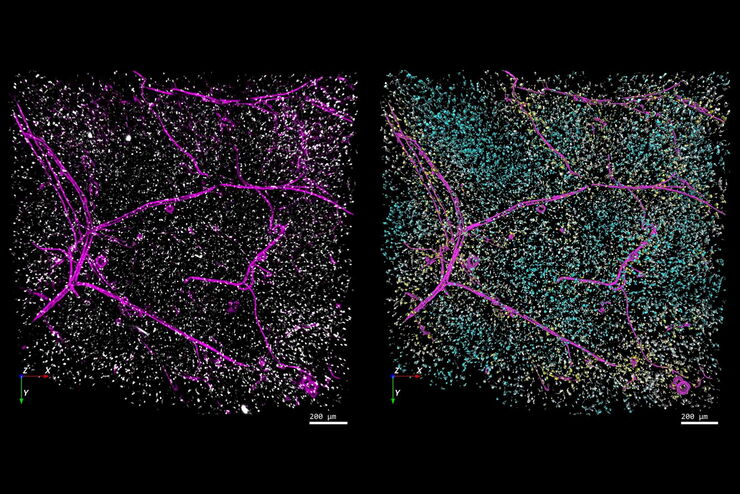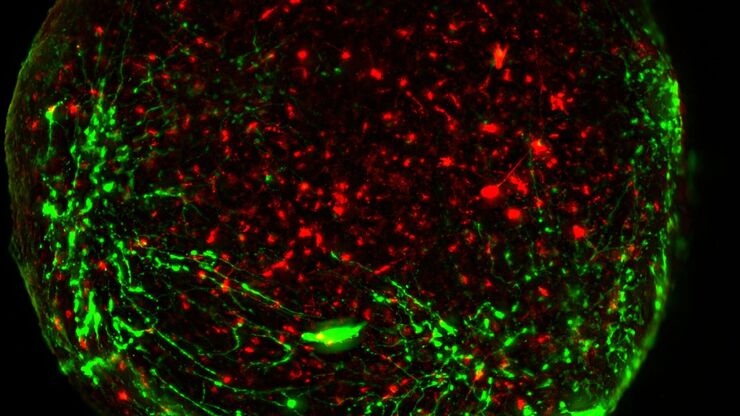Filter articles
标签
产品
Loading...
![[Translate to chinese:] Identification of distinct structures_roundworm_Ascaris_female [Translate to chinese:] Identification of distinct structures_roundworm_Ascaris_female](/fileadmin/_processed_/a/b/csm_Identification_of_distinct_structures_roundworm_Ascaris_female_eddbe9bbff.jpg)
从概览中查找相关样本细节
在从图像到图像的搜索中切换到快速查看整个样本概览,并即刻识别重要的样本细节。利用这些知识,使用载玻片、培养皿和多孔板的模板自动设置高分辨率图像采集。LAS X Navigator软件像是样本细胞的GPS,总能为用户指明通向高质量数据的清晰路径,这是生命科学平台STELLARIS和THUNDER成像仪上的一款强大的导航工具。LAS X Navigator支持将宽场、立体或共聚焦实验与舞台应用相结合。
Loading...

精确分析宽视野荧光图像
利用荧光显微镜的特异性,即便是使用厚样品和大尺寸样品,研究人员也能够快速轻松地准确观察和分析生物学过程和结构。然而,离焦荧光会提高背景荧光,降低对比度,影响图像的精确分割。THUNDER 与Aivia 的组合可以有效解决这一问题。前者可以消除图像模糊,后者会使用人工智能技术自动分析宽视野图像,提高操作速度和精确性。下面,我们来详细了解下这一协作方法。
Loading...

High-resolution 3D Imaging to Investigate Tissue Ageing
Award-winning researcher Dr. Anjali Kusumbe demonstrates age-related changes in vascular microenvironments through single-cell resolution 3D imaging of young and aged organs.
Loading...
![[Translate to chinese:] HeLa Kyoto cells [Translate to chinese:] HeLa Kyoto cells (HKF1, H2B-mCherry, alpha Tubulin, mEGFP). Left image: Maximum projection of a z-stack prior to ICC and LVCC. Right image: Maximum projection of a mosaic z-stack after ICC and LVCC.](/fileadmin/_processed_/6/a/csm_How_to_improve_live_cell_imaging_with_Leica_Nano_Workflow_teaser_6d36e3e6d8.jpg)
如何使用Coral Life(活细胞光电联用)改进活细胞成像
对于活细胞 CLEM 应用而言,光学显微镜成像是在正确的时间以正确的状态识别正确细胞的关键步骤。在本文中,徕卡专家就使用宽场系统的优势以及使用蓝宝石作为细胞培养基底时需要克服的障碍分享了他们的见解。
Loading...

优化 THUNDER 平台以实现高内涵玻片扫描
随着对全组织成像需求的不断增长以及对不同生物标本中 FL 信号定量的需要,HC 成像技术的极限受到了考验,而核心设备的用户可培训性和易用性则成为了成本和效率的问题。在这里,我们展示了在我们的设施中为THUNDER平台开发的可行工作流程,以支持从 KO-小鼠组织分析到人类癌症的各种研究环境需求。
Loading...
![[Translate to chinese:] C. elegans Gonades [Translate to chinese:] C. elegans Gonades - THUNDER Imager Adult hermaphrodit, Staining: blue - DAPI (Nucleus), green - SP56 (sperms), red - RME-2 (oocyte), mangenta - PGL-1 (RNA + protein granules) Image courtesy of Prof. Dr. Christian Eckmann, Martin Luther University, Halle, Germany](/fileadmin/_processed_/3/c/csm_THUNDER-Imager_C-elegans_Gonades_Physiology_3600_59ce4afec3.jpg)
生理学图片库
生理学是关于生物体内的过程和功能。生理学研究的重点是生物体器官、组织或细胞的活动和功能,包括所涉及的物理和化学现象。在此,我们以不同的样本为例,向您展示与生理学有关的图片。

![[Translate to chinese:] Virally labeled neurons (red) and astrocytes (green) in a cortical spheroid derived from human induced pluripotent stem cells. [Translate to chinese:] Virally labeled neurons (red) and astrocytes (green) in a cortical spheroid derived from human induced pluripotent stem cells. THUNDER Model Organism Imagerwith a 2x 0.15 NA objective at 3.4x zoomwas used to produce this 425 μm Z-stack (26 positions), which is presented here as an Extended Depth of Field(EDoF)projection.](/fileadmin/_processed_/e/c/csm_THUNDER_Imager_Model-Org_Header-Gallery-Neuroscience_e911743fb7.jpg)
![[Translate to chinese:] Pollen Flower [Translate to chinese:] Pollen Flower - Taken with a 20x/0.8 objective, area of 6mm² with a depth of 100μm. 15 stitched tiles with 4 colors (DAPI/GFP/TRITC/Cy5) - a total of 13020 images. Video courtesy of James Marr, Leica Microsystems, USA](/fileadmin/_processed_/d/1/csm_THUNDER_Imager_Pollen-Flowe_1febb91d34.jpg)

